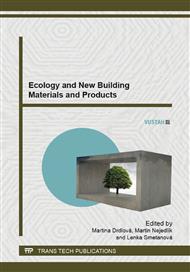[1]
Ch. U. Grosse, M. Ohtsu: Acoustic Emission Testing. Springer-Verlag Berlin Heidelberg. 2008. ISBN 978-3-540-69895-1.
Google Scholar
[2]
M. Matysík, L. Topolář, P. Daněk, T. Vymazal, I. Plšková: The Effect of Concrete Quality on the Acoustic Emission Parameters During Three-point Bending Fracture Test. Advanced Materials Research. 2014. 2014(897). pp.149-152. ISSN 1022-6680.
DOI: 10.4028/www.scientific.net/amr.897.149
Google Scholar
[3]
L. Topolář, L. Pazdera, P. Cikrle: Acoustic Emission Monitoring during Static Modulus Elasticity Test of Concrete Specimen. In 51st Annual of the International Scientific Conference on Experimental Stress Analysis, EAN 2013;, Applied Mechanics and Materials. 1. Switzerland. 2014. pp.267-272.
DOI: 10.4028/www.scientific.net/amm.486.267
Google Scholar
[4]
Z. Chobola, M. Luňák, J. Vaněk, R. Bařinka: Low-frequency noise, microplasma, and electroluminescence measurements as faster tools to investigate quality of monocrystalline-silicon solar cells. Optical Engineering. 2013. 52(5). pp.051203-1.
DOI: 10.1117/1.oe.52.5.051203
Google Scholar
[5]
M. Kořenská, M. Manychová, L. Pazdera: Experimental study of the nonlinear effects generated in a concrete structure with damaged integrity. Russian Journal of Nondestructive Testing. 2013. 49(9). pp.530-537. ISSN 1061-8309.
DOI: 10.1134/s1061830913090040
Google Scholar
[6]
B. Kucharczykova, Z. Kersner, O. Pospichal, P. Misak, T. Vymazal: Influence of freeze-thaw cycles on fracture parameters values of lightweight concrete. Procedia Engineering. 2010. 2(1). pp.959-966. ISSN 1877-7058.
DOI: 10.1016/j.proeng.2010.03.104
Google Scholar
[7]
L. Pazdera, L. Topolář, H. Šimonová, P. Fojtů, J. Smutný, I. Havlíková, Z. Keršner, V. Rodriguezová: Determine Parameters for Double-K Model at Three-Point Bending by Application of Acoustic Emission Method. In 51st Annual of the International Scientific Conference on Experimental Stress Analysis, EAN 2013, Applied Mechanics and Materials. 1. Switzerland. 2014. pp.151-156.
DOI: 10.4028/www.scientific.net/amm.486.151
Google Scholar
[8]
M. Luňák, I. Kusák, Z. Chobola: Dielectric Properties of Concrete Specimens after Heat Stress. Applied Mechanics and Materials. 2014. 2014(446). pp.1389-1394. ISSN 1660-9336.
DOI: 10.4028/www.scientific.net/amm.446-447.1389
Google Scholar
[9]
I. Plšková, Z. Chobola, M. Matysík: Assessment of ceramic tile frost resistance by means of the frequency inspection method. Ceramics-Silikáty. 2011. 55(2). pp.176-182. ISSN 0862-5468.
Google Scholar
[10]
M. Ohtsu: Basics of Acoustic Emission and Applications to Concrete Engineering. Materials Science Research International. 1998. 4 (3). p.131 – 140. ISSN: 1341-1683.
Google Scholar


